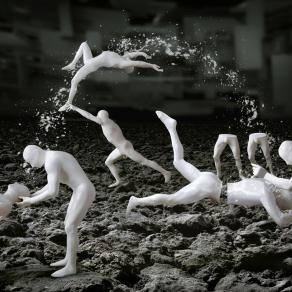Alessandro Bavari
Artist, Roma, Italy, joined 12 years ago
SINOPSYS
Metachaos, from Greek Meta (beyond) and Chaos (the abyss where the eternally-formless state of the universe hides), indicates a primordial shape of ameba, which lacks in precise morphology, and it is characterized by mutation and mitosis.
In fact the bodies represented in METACHAOS, even though they are characterized by an apparently anthropomorphous appearance, in reality they are without identity and conscience. They exist confined in a spaceless and timeless state, an hostile and decadent hyperuranium where a fortress, in perpetual movement, dominates the landscape in defense of a supercelestial, harmonic but fragile parallel dimension. In its destructive instinct of violating the dimensional limbo, the mutant horde penetrates the intimacy of the fortress, laying siege like a virus. Similar to the balance of a philological continuum in human species, bringing the status of things back to the primordial broth.
STATEMENT
METACHAOS is a multidisciplinary audio-visual project, articulated in a short film, a set of photography (alessandrobavari.com/english/Metachaos-photographies/gallery_Metachaos-photographic_series.htm) and mix-technique paintings. The purpose of the project is to represent the most tragic aspects of the human nature and of its motion, such as war, madness, social change and hate. An accretion of feelings that are metaphorically represented by specific visual forms, which are abstract conceptually, but concrete and tangible formally. The application of acid and monochromatic tints, besides the strong contrasts, makes everything intentionally more oppressive and tragic.
In order to obtain a more immersive and plausible version, the shot was taken adopting the camera live technique. The extreme and frenetic motion of the shoulder camera, similar to the subjective one, becomes a main constant, so that, along with the persisting cuts used to edit the video, create a bigger sense of instability and danger. In fact, thanks to the dissemination of Technology, it is possible to notice that the unconscious-esthetic potential of the shots available on Youtube, characterized by a pseudo-documentary and amateur approach, often offer an unexpected emotional involvement, which trigger an exhibitionistic-voyeuristic interchange between the author and the consumer.
The irrational gesture and action of the bodies, as if a collective form of madness controlled them, are inspired by artists like Bosch and Bruegel who, between the ‘400 and ‘500, produced an iconography where irrational images show sickly madness and pain.
The project has been realized using different techniques: live shots taken in discharged industrial sites, CGI animations, tracking and motion captures, besides various other analogical ones.
American Jeff Ensign, aka Evolution Noise Slave composed the original sound track, which has been progressively updated during the video production. The musical score was inspired by 6 separate pieces Jeff had previously created that were then combined into a hybrid. The composition was also based in part from a sonic interpretation of the ideas presented in Antonin Artaud’s the Theater and Cruelty overlaid on Bavari’s images.
JURY STATEMENT FROM PRIX ARS ELECTRONICA 2011.
Alessandro Bavari’s “Metachaos” is an impressive display of the amazing graphics that can be produced with leading-edge hardware and software. The 8-minute clip begins with a sequence of clear, geometric forms that suggest a serene world. But it doesn’t take long until it’s apparent that this was just the calm before the storm. Shadowy creatures and shockingly grotesque figures intrude into this domain rendered in black & white and sepia tones and rip it to pieces. Using the interplay of light and shadow, intentionally shaky camera movements and quick cuts, Bavari takes us on a tour de force through an unsettling imaginary cosmos that grips viewers and doesn’t let them loose. In addition to its extraordinary visuals, “Metachaos” features an impressive composed soundscape of incredibly concentrated intensity—noise elements paired with driving beats, panic-stricken screams, the rattling of bones and gale-force winds.
While some of as did not necessarily share the apocalyptic view of this film, we found that it left the most indelible impression. Narrowly passing through the first round, it grew on us, so that on repeated viewing it miraculously made its way to the top.
What starts as a cinematic, kinetik, yet clean field of geometry and bodies, gradually evolves, or devolves, into the artist’s vision of a nightmarish black-and-white world created by a continual collision of the human and the architectural form. It finally culminates in a screaming dance among the ruins. In a impressive virtuoso tour de force, Alessandro Bavari creates a constant mêlée of grime, projectile muck and dust among collapsing spaces at the stage for metamorphosing human bodies with branching limbs that seem constantly to break the architectural environment apart. Zombies with missing limb sand decaying skin and faces sometimes stand around listlessly and other times appear to engage in orgasmic sex. The human forms become insect-like and multiply in hordes across the building forms. Dust particles and snakes of turbolent, ferrous liquid finally explode into an apocalyptic ocean of flotsam and sludge.
Bavari’s few collaborators helped shape what the credit call “camera tremula” (shaky, documentary-style camera) and sound design. We commend his dedication to a singular artistic vision that is grounded in his practice as a photographer. This is a representation of a caustic end of the world, a world of a audible pain and hopeless destruction rendered with a disturbing reference to 80s-style computer-generated animation as well as 60s “actionism”.
News
celeste,

















